Anritsu ML2490A Pulsed RF Power Meter Series up to 65 GHz
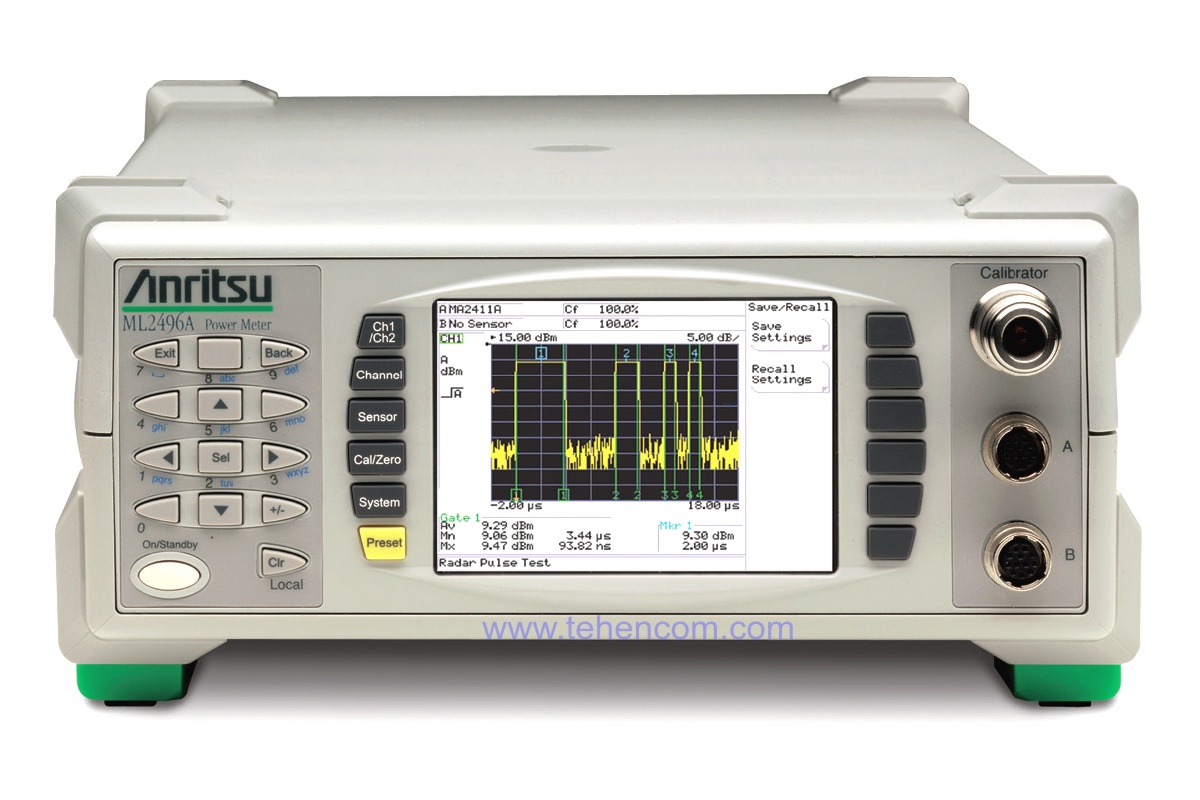
Product code: 1000166
Add item to cart. Our specialist will coordinate with you the complete set, tell you the price and delivery time.
Price on request
SHORT DESCRIPTION
Series Power Meters Anritsu ML2490A are high-speed digitizers and processors of signals coming from power sensors (sensors) connected to them. The Anritsu ML2495A model is single-channel and supports the connection of one sensor, while the Anritsu ML2496A model can work simultaneously with two different sensors. Depending on the types of sensors connected, the frequency range can be from 100 kHz to 65 GHz.
Due to the very high digitization rate (time resolution reaches 1 ns), the Anritsu ML2490A series meters can be used for the development and tuning of radars, and the bandwidth of these devices, equal to 65 MHz, allows them to be used at all stages of construction and operation of 3G wireless communication systems, 4G and 5G, including next generation systems based on sophisticated modulation technologies such as OFDM.
In addition to pulse and peak power sensors, the Anritsu ML2490A series can be connected to a variety of sensors to measure fixed radio signals (CW), making it versatile in applications. You can download a full description of all the characteristics of the Anritsu ML2490A series below on this page in the section Documentation.
Main characteristics:
Number of channels: 1 (model ML2495A) or 2 (model ML2496A).
Frequency: 100 kHz - 65 GHz (depending on the sensor).
Bandwidth (video bandwidth): 65 MHz.
Typical rise time: 8 ns (with MA2411B encoder).
Time resolution: 1 ns. Built-in power calibrator (50 MHz and 1 GHz).
Ideal for radar applications and wireless networks (4G and 5G).
Power measurements: Average, Min, Max, Peak, Crest, PAE (Power Added Efficiency).
8.9 cm screen (320 x 240 resolution). Interfaces: Ethernet, IEEE-488 (GPIB), RS-232.
Weight: 3 kg. Dimensions: 213 x 88 x 390 mm. Working temperature: from 0°С to +50°С.
Accurate measurement of the power of any radio signal
Need selective radio signal power meter? see model Anritsu MA24507A.
Want to see the full list of models? See: complete list of power sensors.
DETAILED DESCRIPTION
Anritsu's ML2490A RF Power Meter Series delivers superior performance over the other two Anritsu RF meter series (ML2480B and ML2430A). The ML2490A series includes two models: single channel ML2495A and dual channel ML2496A. Both models work together with external sensors (sensors). The Anritsu ML2490A power meters are compatible with six series of sensors that cover a very wide range of applications in the frequency range from 10 MHz to 50 GHz and in the power range from -70 dBm to +20 dBm.
Depending on the type of sensor connected, Anritsu ML2490A meters can measure the following signal strength parameters: Average (average value), Min (minimum value), Max (maximum value), Peak (peak value), Crest (peak factor), Rise- time (rise time), PAE (Power Added Efficiency - power summation efficiency), etc. To calibrate sensors, Anritsu ML2490A instruments contain a built-in power calibrator for two frequencies: 50 MHz and 1 GHz as a standard feature.
This photo shows the Anritsu ML2495A single channel RF power meter and the Anritsu ML2496A dual channel RF power meter along with the two best sensors: the Anritsu MA2411 pulse probe (up to 40 GHz) and the Anritsu MA2491A wideband probe (up to 18 GHz).
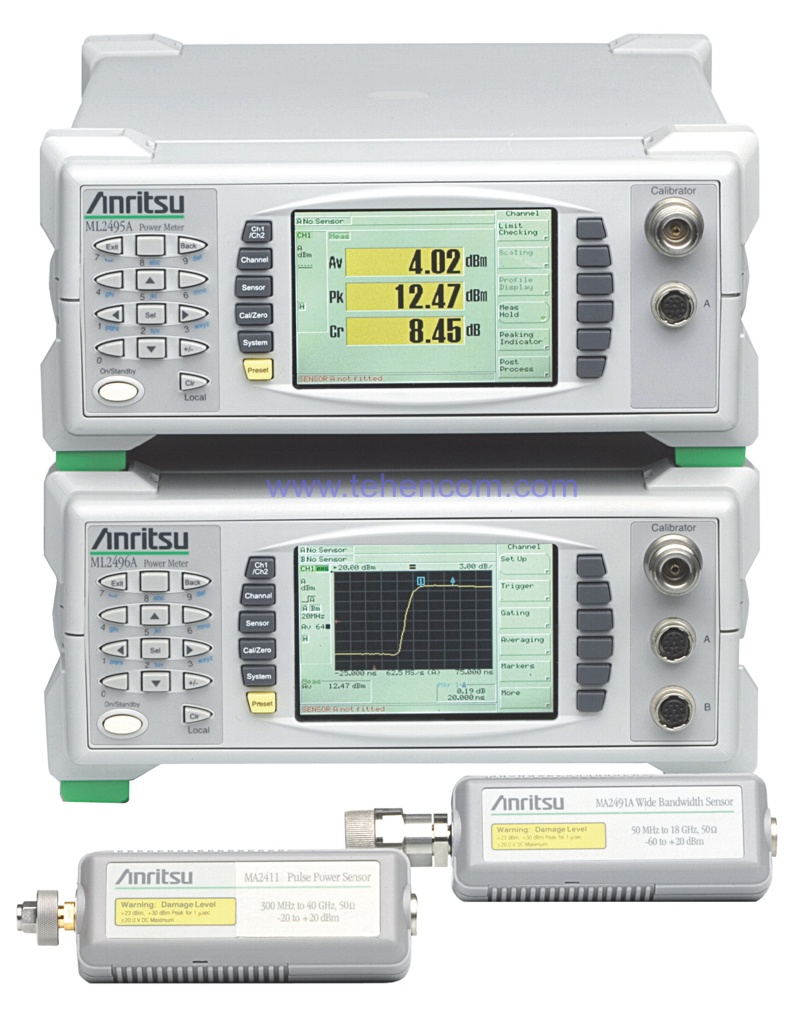
Sensor (sensor) of impulse power Anritsu MA2411B
The Anritsu ML2495A and ML2496A power meters, together with the Anritsu MA2411B sensor, are ideal for measuring pulsed radio signals in the 300 MHz to 40 GHz frequency range. With a typical rise time of 8 ns and a resolution of 1 ns, it is possible to directly measure the characteristics of radar pulses, as well as a large number of other types of signals having a pulse or burst structure.
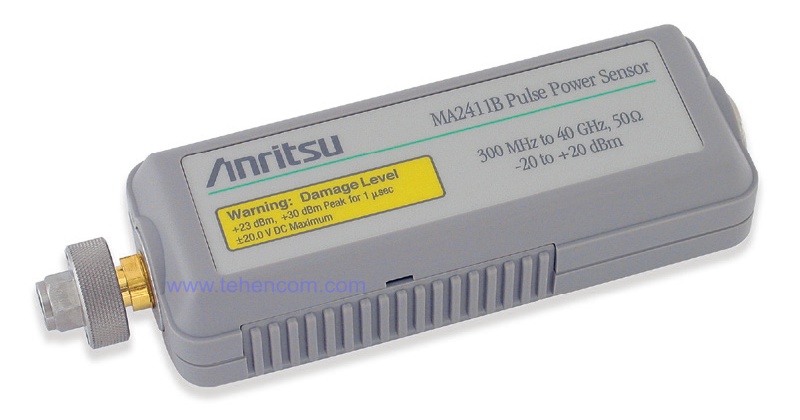
This photo shows a screen shot of the Anritsu ML2496A power meter showing RF edge measurements. The measurements were carried out using an Anritsu MA2411B pulsed power sensor. The scale on the horizontal axis is 20 ns per division, and on the vertical axis is 3 dB per division. The signal coming from the sensor was digitized at a rate of 62.5 MS/s.
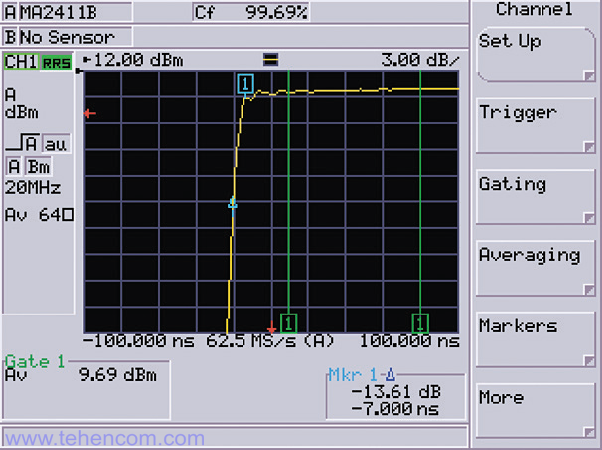
This photo shows a screen shot of an Anritsu ML2496A power meter showing the measurement results of four consecutive RF pulses. The scale on the horizontal axis is 2 µs per division and on the vertical axis is 5 dB per division. For each pulse, you can measure: rise time, fall time, duration and other parameters, including the pulse repetition interval PRI (Pulse Repetition Interval). The results for a group of pulses are also displayed on the screen: minimum, maximum and average power values.
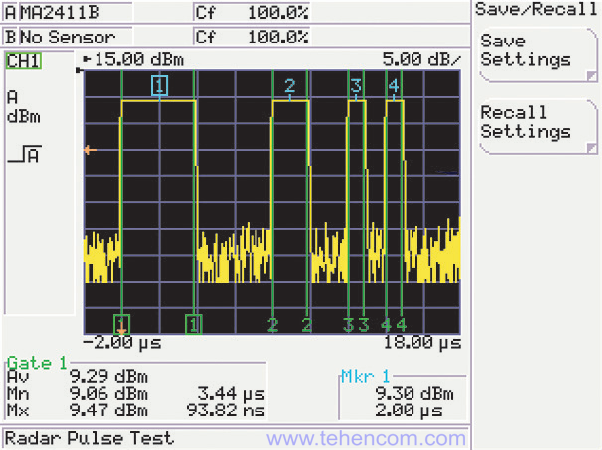
When measuring strong radio signals, attenuators or couplers are often used. Anritsu ML2490A series power meters have the ability to automatically take into account the value of an external attenuator or coupler so that the measurement results on the screen correspond to the real power.
Before using the Anritsu MA2411B sensor with the ML2490A series power meter, they must be calibrated together. To do this, the output of the reference signal (Calibrator) with a frequency of 1 GHz and an amplitude of 0 dBm (1 mW) is located on the front panel of the power meter. By connecting the sensor to this output and pressing the corresponding menu item, you will calibrate the sensor and zero the errors of the measuring path, which will prepare the device for accurate measurements.
The Anritsu MA2411B is optimized for measuring pulsed and wideband modulated signals, but can be successfully used to accurately measure the characteristics of stationary (CW) and slowly varying radio signals. The corresponding screenshot is shown in this photo.
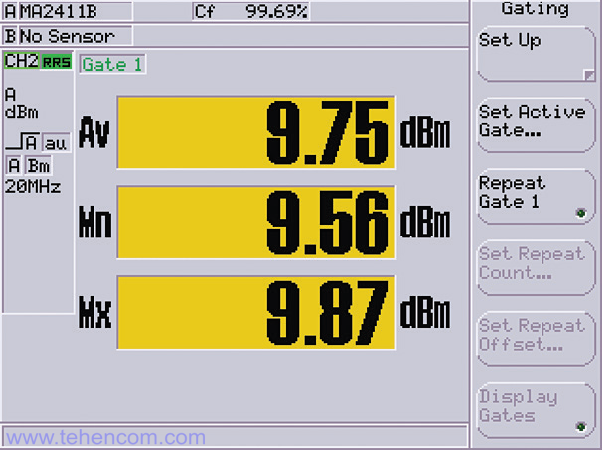
Anritsu MA2490A and MA2491A Broadband Power Sensors
To measure the parameters of telecommunication signals, as well as some types of impulse signals, two wideband sensors are designed: Anritsu MA2490A (from 50 MHz to 8 GHz) and Anritsu MA2491A (from 50 MHz to 18 GHz). Both sensors provide a bandwidth of 20 MHz (also referred to as video bandwidth or response rate), which is sufficient to accurately measure rapidly changing signals such as 3G/4G, WLAN, WiMAX and the pulses of most types of radar systems. The rise time of these sensors in the pulse measurement mode is 18 ns.
The impulse responses of the MA2490A and MA2491A are slightly worse than those of the MA2411B discussed above, but the minimum measurable power is -60dBm instead of -20dBm for the MA2411B. A significant expansion of the lower power threshold is achieved due to the presence of an additional measuring path inside the sensors, which automatically turns on at low power values.
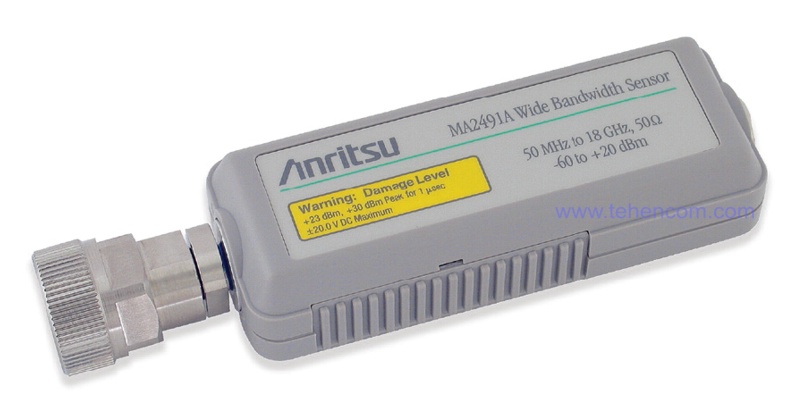
This photo shows a screen shot of the Anritsu ML2496A power meter with the results of measurements of the GSM signal parameters. The measurements were carried out using an Anritsu MA2491A broadband power sensor. The scale on the horizontal axis is 48 µs per division, and on the vertical axis is 5 dB per division. The peak power of individual signal fragments reaches 12 dBm.
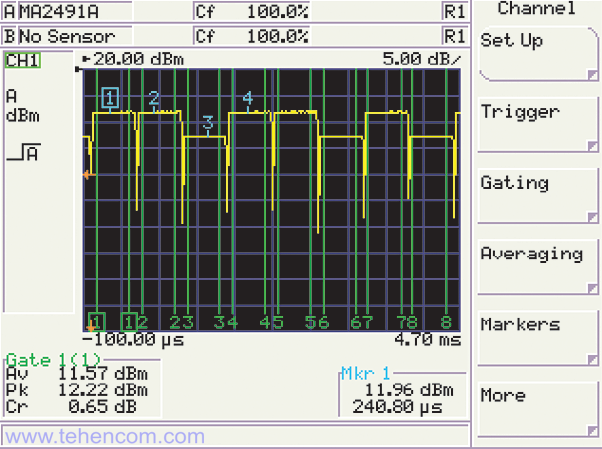
Anritsu MA2440D high-precision diode power sensors (sensors)
This series of high-precision sensors is designed for radio signals with a low rate of change or modulation (for example, TDMA), as well as stationary (CW - Continuous Wave) signals. The response speed (video bandwidth) of these sensors is 100 kHz and the rise time is 4 µs. All MA2440D Series sensors have a built-in 3dB attenuator that greatly improves the match (SWR) of the sensor's RF input connector. The wide 87dB dynamic range and better than 1.8% (up to 18 GHz) and 2.5% (up to 40 GHz) linearity make these sensors ideal for a wide range of applications including radio gain and attenuation measurements.
The Anritsu MA2440D series of sensors consists of three models that differ in the upper frequency range and the type of input connector: model MA2442D (from 10 MHz to 18 GHz, connector N(m)), model MA2444D (10 MHz to 40 GHz, connector K(m)) and model MA2445D (from 10 MHz to 50 GHz, connector V(m)). For example, this photo shows an Anritsu MA2444D sensor with a K(m) connector.
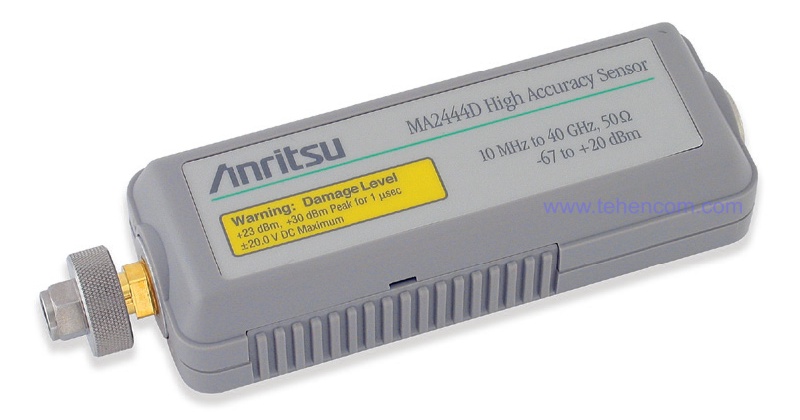
High-precision power sensors (sensors) based on the thermal effect of the Anritsu MA24000A series
This series of high-precision sensors is designed for stationary (CW - Continuous Wave) and slowly changing radio signals. The rise time for these sensors is 15 ms. The principle of operation of this series of sensors is based on the thermoelectric effect, which allows you to accurately measure the average (average) power of any radio signal, regardless of its structure or modulation type. The dynamic range of these sensors is 50 dB and the linearity is better than 1.8% (up to 18 GHz) and 2.5% (up to 50 GHz).
The Anritsu MA24000A series of sensors consists of three models that differ in the upper frequency range and the type of input connector: model MA24002A (from 10 MHz to 18 GHz, connector N(m)), model MA24004A (10 MHz to 40 GHz, connector K(m)) and model MA24005A (10 MHz to 50 GHz, connector V(m)). All three sensors of the Anritsu MA24000A series are shown in this photo.
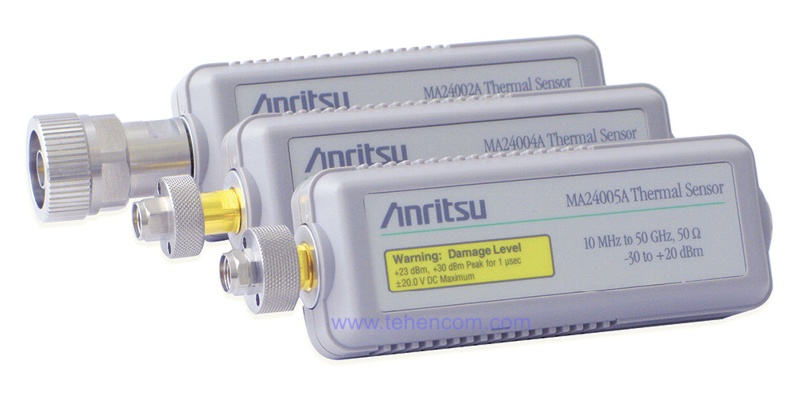
The principle of operation and the internal structure of the Anritsu ML2490A series power meters
The power sensors connected to the Anritsu ML2490A series meters have the function of converting the high frequency signal whose power is to be measured into a low frequency signal. This low-frequency signal comes from the sensor to the input of the ML2490A series meter, is digitized using the built-in ADC, processed by a digital signal processor and displayed on the instrument display.
This figure shows the block diagram of the single channel model ML2495A. In this block diagram, two ADCs (analogue-to-digital converters) are highlighted in green, with the help of which the low-frequency signal coming from the power sensor connected to the meter is digitized. If an Anritsu MA2440D series diode sensor or Anritsu MA24000A series thermoelectric sensor is connected, then digitization is performed using a 16-bit ADC. And if an Anritsu MA2411B pulse encoder or Anritsu MA2490A or MA2491A wideband encoders are connected, then digitization is performed using a high-speed 14-bit ADC.
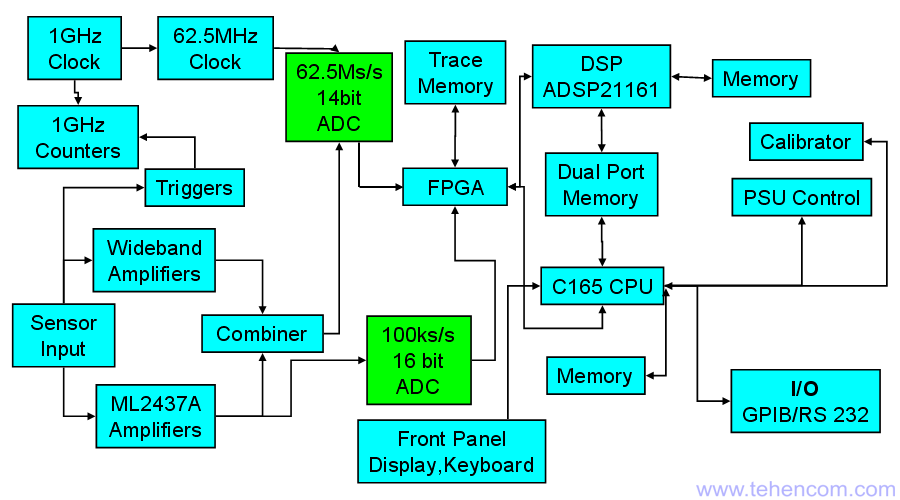
And this is what the internal structure of the Anritsu ML2490A series power meter looks like. In the center is a small rectangular board of the built-in calibrator for 50 MHz and 1 GHz, the high-frequency cable from which is connected to the N connector on the front panel. Under the calibrator board is a large measurement board containing the analog part, ADC and an array of programmable logic matrices. Immediately below the measurement board is a second large digital processing and control board containing a DSP (digital signal processor), a microcontroller and digital display and control units.
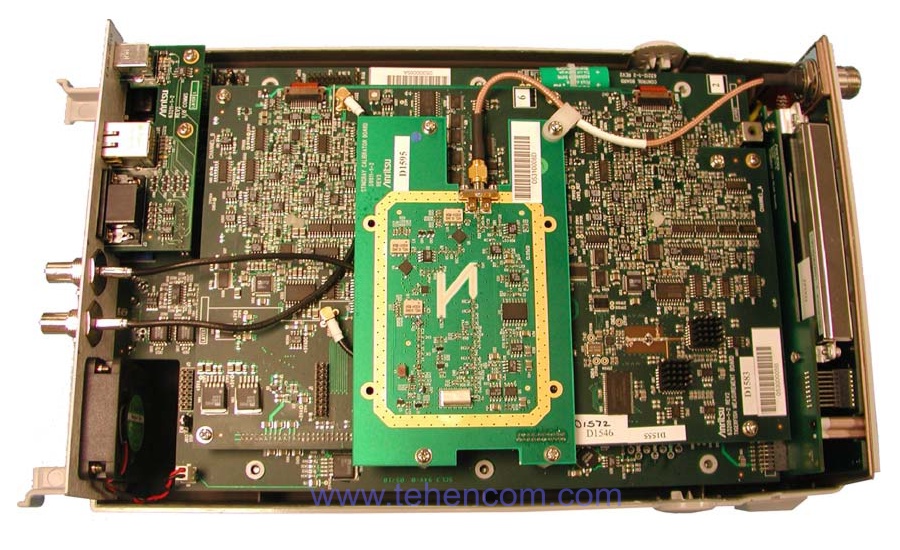
Anritsu PowerMax remote control software
All Anritsu ML2490A series power meters are supplied with remote control software. Anritsu PowerMax. This program runs on a Windows compatible PC and allows you to remotely control the Anritsu ML2495A single channel instrument or Anritsu ML2496A dual channel instrument. Performing measurements with the PowerMax software simplifies the initial setup of the instrument, speeds up the processing of measurements, and makes it easy to document and store results.
An example of the main window of the Anritsu PowerMax program is shown in this screenshot. In this case, the two-channel Anritsu ML2496A model is controlled, the first channel of which is connected to the Anritsu MA2411B pulsed power sensor, and the second channel is the Anritsu MA2491A wideband power sensor.
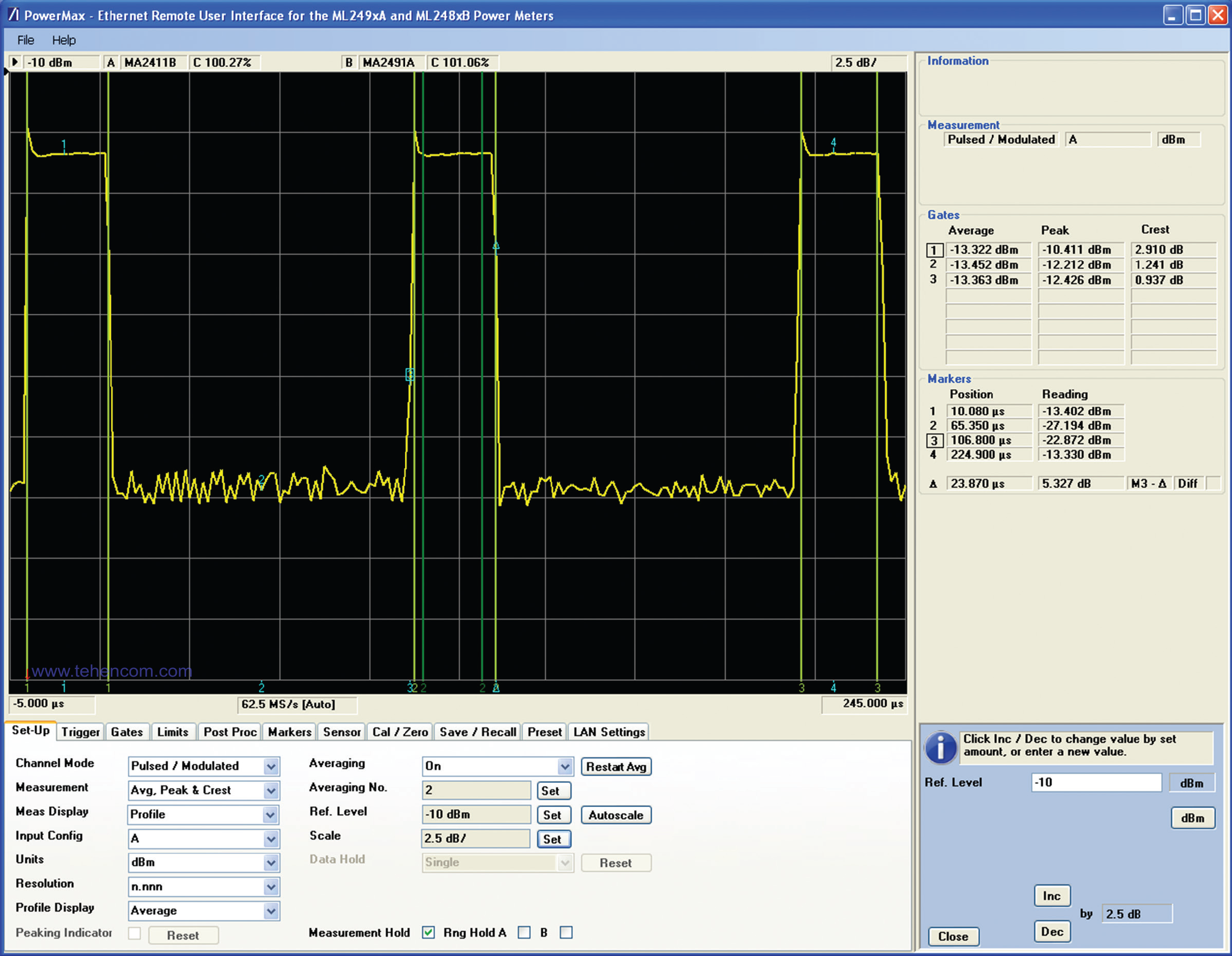
Specifications for Anritsu ML2490A Meters and Power Sensors
Below is a list of the main technical specifications of the Anritsu ML2490A series power meters. For detailed technical characteristics of the meters, see below on this page in the section Documentation.
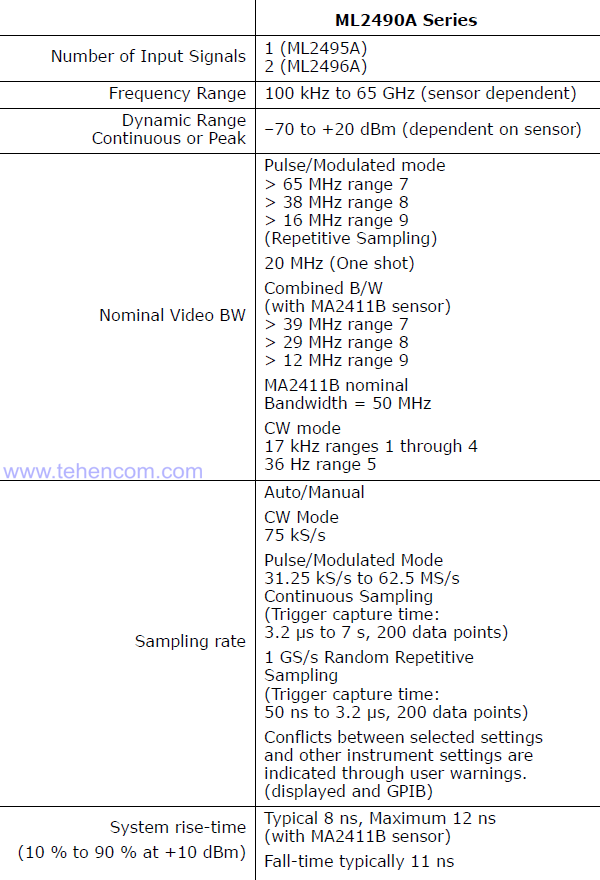
Below is a list of the main specifications of the various types of power sensors (power sensors) that are compatible with the Anritsu ML2490A series meters. For detailed technical characteristics of the sensors, see below on this page in the section Documentation.
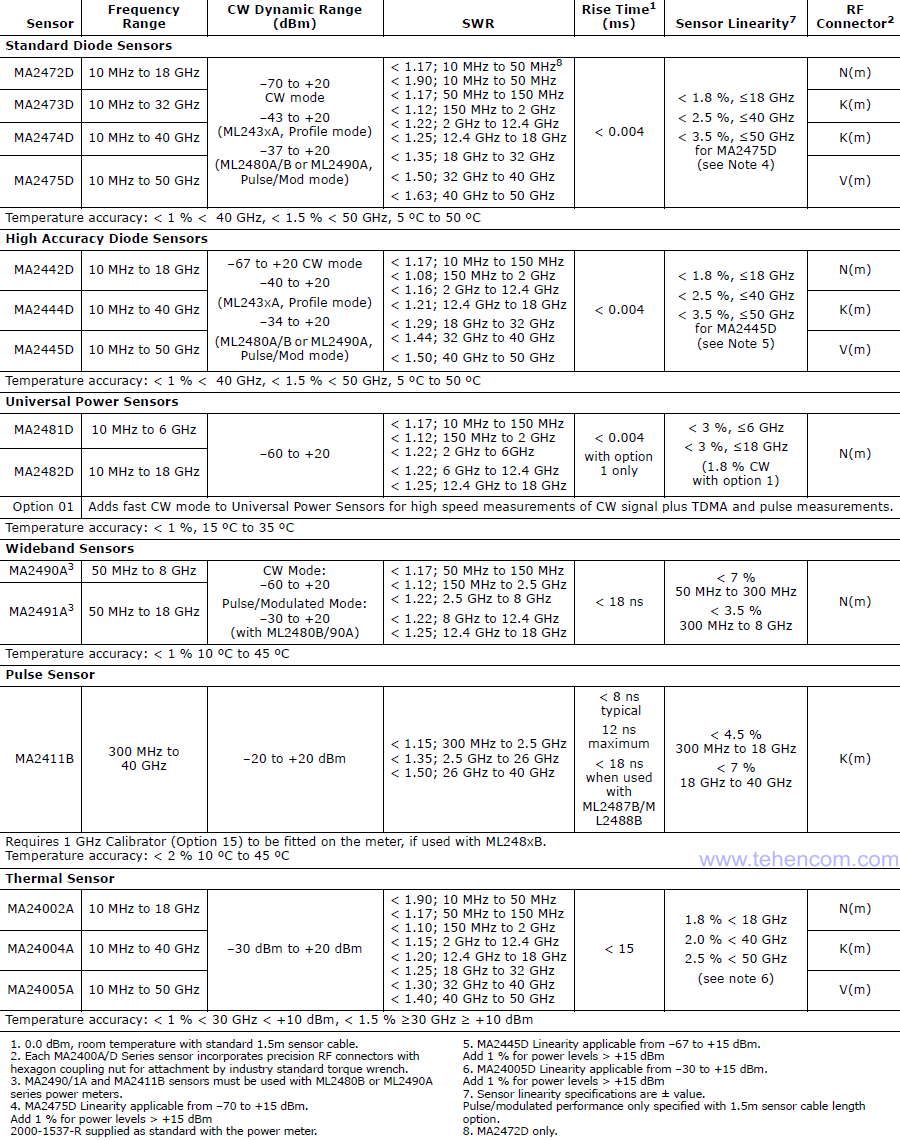
Anritsu ML2490A Series Power Meter Package
| Name | Short description |
| Anritsu ML2495A | Single-channel power meter for pulsed, modulated and stationary radio signals |
| or | |
| Anritsu ML2496A | Two-channel power meter for pulsed, modulated and stationary radio signals |
| a plus: | |
| 2000-1537-R | Cable 1.5 meters for connecting the sensor (1 pc. for each channel) |
| - | Power cable |
| - | Optical disc with documentation and PowerMax software |
| - | Calibration certificate |
| - | 1 year warranty (can be extended to 3 and 5 years) |
Options and accessories for Anritsu ML2490A series power meters
Main options:
- option 760-209 (hard transport case for transporting the device and accessories).
- option D41310 (soft bag for transporting the device with a shoulder strap).
- option
2400-82 (rack-mount kit for one meter).
- option 2400-83 (rack-mount kit for two meters).
- option 2000-1535 (protective cover for the front panel).
- option
2000-1536-R (cable 0.3 meters for connecting the measuring sensor).
- option 2000-1537-R (cable 1.5 meters for connecting the measuring sensor).
- option 2000-1544 (RS-232 cable for device flashing).
Compatible power sensors (sensors):
- sensor Anritsu MA2411B (pulse sensor 300 MHz to 40 GHz, -20 dBm to +20 dBm).
- sensor Anritsu MA2490A (wideband sensor from 50 MHz to 8 GHz, -60 dBm to +20 dBm).
- sensor Anritsu MA2491A (wideband sensor from 50 MHz to 18 GHz, -60 dBm to +20 dBm).
- sensor Anritsu MA2472D (Standard diode sensor 10 MHz to 18 GHz, -70 dBm to +20 dBm).
- sensor Anritsu MA2473D (Standard diode sensor 10 MHz to 32 GHz, -70 dBm to +20 dBm).
- sensor Anritsu MA2474D (standard diode sensor 10 MHz to 40 GHz, -70 dBm to +20 dBm).
- sensor Anritsu MA2475D (standard diode sensor 10 MHz to 50 GHz, -70 dBm to +20 dBm).
- sensor Anritsu MA2442D (high-precision diode sensor from 10 MHz to 18 GHz, from -67 dBm to +20 dBm).
- sensor
Anritsu MA2444D (high-precision diode sensor from 10 MHz to 40 GHz, from -67 dBm to +20 dBm).
- sensor Anritsu MA2445D (high-precision diode sensor from 10 MHz to 50 GHz, from -67 dBm to +20 dBm).
- sensor Anritsu MA2481D (universal sensor from 10 MHz to 6 GHz, -60 dBm to +20 dBm).
- sensor Anritsu MA2482D (universal sensor from 10 MHz to 18 GHz, -60 dBm to +20 dBm).
- sensor Anritsu MA24002A (thermoelectric sensor from 10 MHz to 18 GHz, from -30 dBm to +20 dBm).
- sensor Anritsu MA24004A (thermoelectric sensor from 10 MHz to 40 GHz, from -30 dBm to +20 dBm).
- sensor Anritsu MA24005A (thermoelectric sensor from 10 MHz to 50 GHz, from -30 dBm to +20 dBm).
Documentation
This PDF documentation contains the most comprehensive description of the Anritsu ML2490A series power meters features, specifications and modes of operation:
Description of power meters Anritsu ML2490A and sensors to them (in English) (12 pages; 7 MB)
Specifications for Anritsu ML2490A meters and sensors for them (in English) (12 pages; 1 MB)
Anritsu ML2490A Power Meters User Manual (English) (224 pages; 3 MB)
Anritsu ML2490A Meter Programming Guide (English) (278 pages; 3 MB)
Brief information about instruments for measuring the power of radio signals (in English) (4 pages; 2 MB)
And here you can find our tips and other useful information on this topic:
A Brief Overview of All Series of Anritsu RF Measuring Instruments
An overview of all series of Anritsu handheld RF analyzers
How to buy equipment cheaper - discounts, special prices, demo and used devices
To simplify the process of choosing a power meter or sensor, you can use our experience and recommendations. We have over 20 years of practical supply experience and can immediately answer many questions about models, options, delivery times, prices and discounts. This will save your time and money. For this it's simple call us or write to us at Email and we will be happy to answer your questions.